
The M61 Vulcan is a hydraulically, electrically, or pneumatically driven, six-barrel, air-cooled, electrically fired Gatling-style rotary cannon which fires 20 mm × 102 mm rounds at an extremely high rate. The M61 and its derivatives have been the principal cannon armament of United States military fixed-wing aircraft for over sixty years.
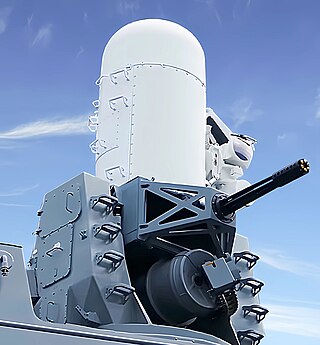
The Phalanx CIWS is an automated gun-based close-in weapon system to defend military watercraft automatically against incoming threats such as aircraft, missiles, and small boats. It was designed and manufactured by the General Dynamics Corporation, Pomona Division, later a part of Raytheon. Consisting of a radar-guided 20 mm (0.8 in) Vulcan cannon mounted on a swiveling base, the Phalanx has been used by the United States Navy and the naval forces of 15 other countries. The U.S. Navy deploys it on every class of surface combat ship, except the Zumwalt-class destroyer and San Antonio-class amphibious transport dock. Other users include the British Royal Navy, the Royal Australian Navy, the Royal New Zealand Navy, the Royal Canadian Navy, and the U.S. Coast Guard.

The Goalkeeper CIWS is a Dutch close-in weapon system (CIWS) introduced in 1979. It is an autonomous and completely automatic weapon system for short-range defence of ships against highly maneuverable missiles, aircraft and fast-maneuvering surface vessels. Once activated the system automatically undertakes the entire air defence process from surveillance and detection to destruction, including the selection of the next priority target.

The M197 electric cannon is a 20 mm three-barreled electric Gatling-type rotary cannon used by the United States military.
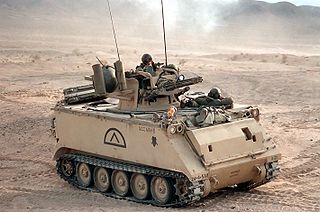
The M163 Vulcan Air Defense System (VADS), officially Gun, Air Defense Artillery, Self-Propelled 20-mm, M163, is a self-propelled anti-aircraft gun (SPAAG) that was primarily used by the United States Army. The M163 provides mobile, short-range air defense protection for ground units against low-flying fixed-wing aircraft and helicopters. It replaced the M42 Duster as the standard American armored light air-defense gun.

A rotary cannon, rotary autocannon, rotary gun or Gatling cannon, is any large-caliber multiple-barreled automatic firearm that uses a Gatling-type rotating barrel assembly to deliver a sustained saturational direct fire at much greater rates of fire than single-barreled autocannons of the same caliber. The loading, firing and ejection functions are performed simultaneously in different barrels as the whole assembly rotates, and the rotation also permits the barrels some time to cool. The rotating barrels on nearly all modern Gatling-type guns are powered by an external force such as an electric motor, although internally powered gas-operated versions have also been developed.

The M247 Sergeant York DIVAD was a self-propelled anti-aircraft gun (SPAAG), developed by Ford Aerospace in the late 1970s. Based on the M48 Patton tank, it replaced the Patton's turret with a new one that featured twin radar-directed Bofors 40 mm rapid-fire guns. The vehicle was named after Sergeant Alvin York, a famous World War I hero.

The Oerlikon GDF or Oerlikon 35 mm twin cannon is a towed anti-aircraft gun made by Oerlikon Contraves. The system was originally designated 2 ZLA/353 ML but this was later changed to GDF-001. It was developed in the late 1950s and is used by around 30 countries.
Point defence is the defence of a single object or a limited area, e.g. a ship, building or an airfield, now usually against air attacks and guided missiles. Point defence weapons have a smaller range in contrast to area-defence systems and are placed near or on the object to be protected.
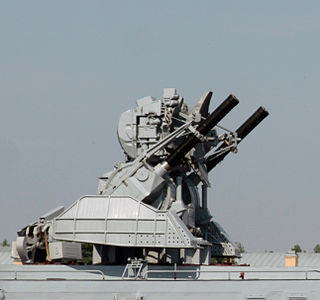
The Kortik close-in weapon system (CIWS) is a modern naval air defence gun-missile system deployed by the Russian Navy. Its export version is known as Kashtan, with the NATO designation CADS-N-1 Kashtan.
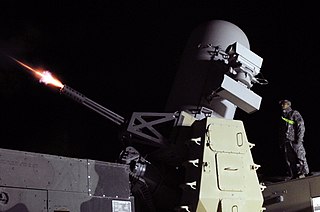
Counter rocket, artillery, and mortar, abbreviated C-RAM or counter-RAM, is a set of systems used to detect and/or destroy incoming rockets, artillery, and mortar rounds in the air before they hit their ground targets, or simply provide early warning.
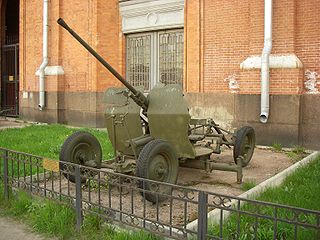
25 mm automatic air defense gun M1940 (72-K) was a Soviet 25 mm caliber anti-aircraft gun used during the World War II. The gun was developed from the end of 1939 to the beginning of 1940 at 8th Kalinin Artillery Plant under the guidance of its Chief Designer Mikhail Loginov, supervised by Lev Loktev. The cannon was given the factory code 72-K before being accepted into service by the Red Army as the 25 mm automatic air defense gun M1940.

The T249 Vigilante was a prototype 37 mm self-propelled anti-aircraft gun (SPAAG) designed as a replacement for the Bofors 40 mm gun and M42 Duster in US Army service. The system consisted of a 37 mm T250 six-barrel Gatling gun mounted on a lengthened M113 armored personnel carrier platform.

United States Army air defense relies on a range of ground launched missiles, ranging from hand held to vehicle mounted systems. The Air Defense Artillery is the branch that specializes in anti-aircraft weapons. In the US Army, these groups are composed of mainly air defense systems such as the PATRIOT Missile System, Terminal High Altitude Air Defense, and the Avenger Air Defense system which fires the FIM-92 Stinger missile.
The XM301 Cannon was an externally powered, three-barrel 20 mm rotary cannon made by General Dynamics for the United States Army. Developed for use with the RAH-66 Comanche stealth helicopter, it is the world's lightest 20 mm rotary cannon. The XM301 was designed to be a versatile and accurate lightweight cannon that could serve both an air-to-air and air-to-ground role. Development and manufacture of the XM301 was cancelled in 2004 along with its parent RAH-66 program.














